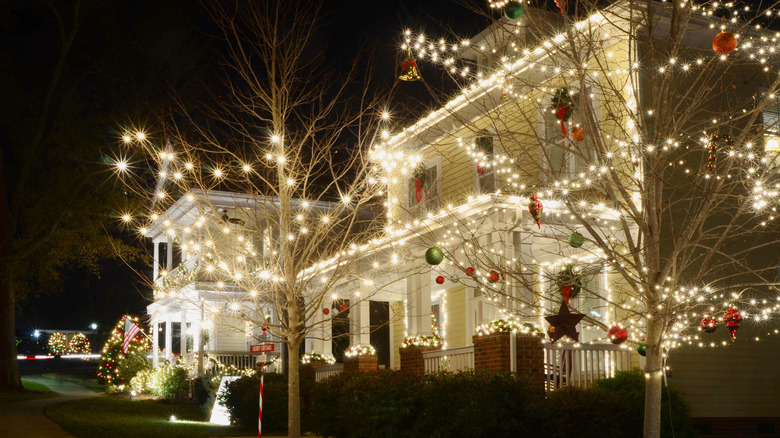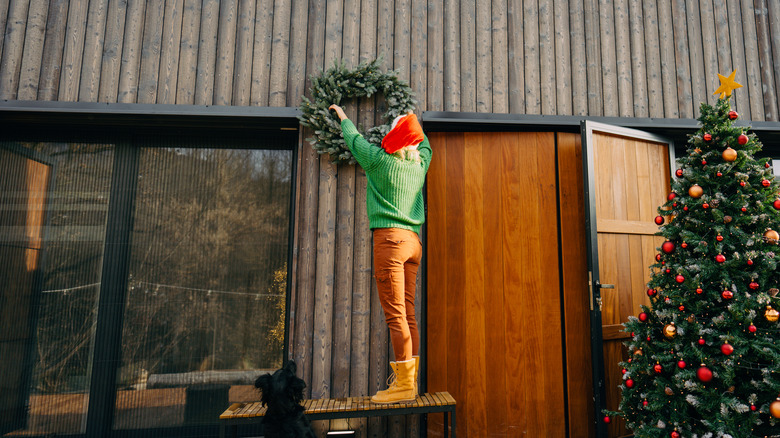The Holiday Decor Mistake That May Be Scaring Birds Away From Your Yard
As winter settles in and our favorite long-awaited holidays draw nearer, our neighborhoods undergo a dazzling metamorphosis. Twinkling lights transform the ordinary into the extraordinary, creating enchanting wonderlands that illuminate the darkness of the season. From rooftop fairy lights to elaborate lawn displays, we spare no effort in making our abodes stand out in the tapestry of holiday decorations. However, within this celebration, it's crucial to ponder the unintended consequences of the holiday lights we use on the wildlife that coexists with us in urban and suburban spaces, especially birds. The migratory patterns of our feathered friends can get thrown off, and they can also become tangled in the wiring we use for our luminous displays.
So, as we revel in the seasonal glow, and get ready to put up lights outside to illuminate our home exterior and spread some holiday cheer, it's essential to know that these seemingly harmless decorations can pose significant harm to the avian inhabitants of our communities.
Unintended consequences for birds
While our intentions are undoubtedly pure, the exuberant use of outdoor Christmas lights can have profound and often overlooked effects on bird populations. The relentless brightness can disrupt the natural behaviors of birds, particularly migratory species that rely on celestial cues for navigation. According to a 2018 study published in Scientific Reports, the light pollution produced by artificial lights at night (ALAN) — including our dazzling holiday light displays — can lead to the disorientation of migratory birds.
Yet, it's not just the lights themselves that pose risks to wildlife; the web of wires and cables accompanying these festive decorations poses a tangible threat. Birds and other wildlife, being inquisitive by nature, can become entangled, leading to injuries and potentially fatal outcomes. The tangled mess of cords and cables may seem innocuous to us, but to a bird or animal exploring its environment, they become potential traps, turning our festive decorations into inadvertent hazards.
Additionally, the increasing popularity of synchronized musical lights can heighten stress levels among birds. The harmonious melodies that delight us may potentially disrupt the intricate auditory communication vital for avian survival. Scientific American reports this interference can impact birds' ability to orient themselves on their usual migration routes. In a 2020 study published in Nature, the discussion centered on how sensory pollutants like artificial light and noise pollution can also affect how birds attract or coordinate with their mates, when they start nesting, and the number of offspring they produce.
Tips for wildlife-friendly festive lighting
To strike a balance between festive exuberance and wildlife conservation, adopt thoughtful approaches. Exercise restraint in decoration, focusing on specific areas rather than drowning your property in a sea of lights. To mitigate the risk of entanglement, secure cables close to surfaces or employ elevated supports, creating safe passages for our feathered friends. Be mindful of the duration your lights remain illuminated; allowing periods of darkness can provide essential respite for nocturnal species and contribute to a healthier ecosystem.
As responsible stewards of the environment, it's crucial to recognize that our well-intentioned holiday displays, beyond their visual impact, can have far-reaching consequences on the delicate lives of other creatures. By embracing these wildlife-friendly holiday decorating practices, we can illuminate our homes with festive cheer while ensuring the magic of the season extends to our avian companions, fostering a harmonious coexistence between the joy of the holidays and the preservation of our natural world.


